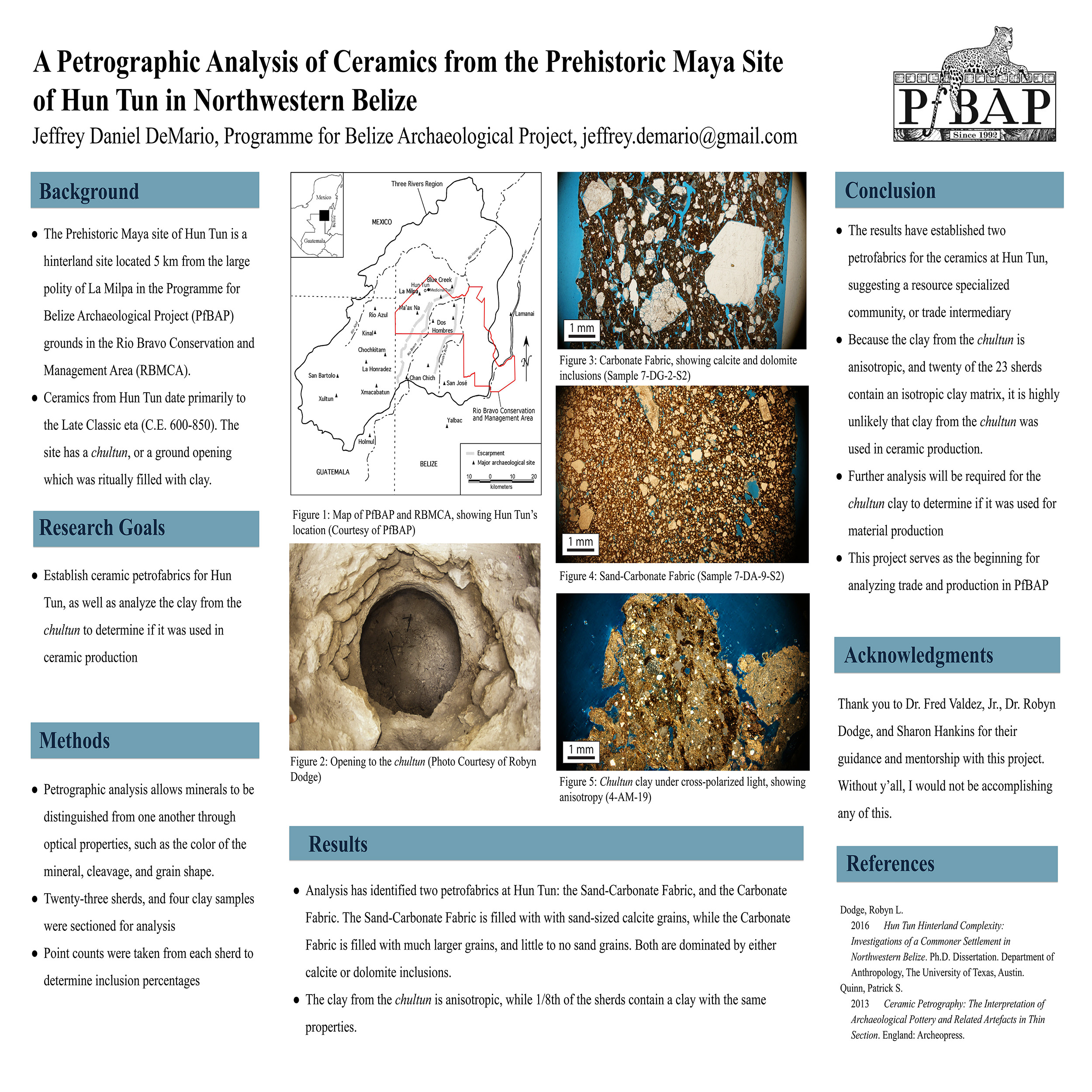Jeffrey Daniel DeMario
A petrographic analysis was conducted on sherd samples from the small prehistoric Maya site of Hun Tun, located in the hinterlands of the larger elite polity, La Milpa, in Northwestern Belize. Hun Tun contains a chultun, an archaeological feature in the ground which was filled with a clay which was lacking in inclusions. Dr. Robyn Dodge, the archaeologist who first investigated Hun Tun, interpreted the chultun as being used for ritual storage. Twenty-three sherds, as well as four clay samples were made into thin sections, before being viewed under a Zeiss Axioskop 40 polarizing microscope in the Graduate Microscopy Lab in the Jackson School of Geosciences at the University of Texas at Austin. Quantitative and qualitative analysis has shown two distinct petrofabrics at Hun Tun, which I have called the Sand-Carbonate Fabric, and the Carbonate Fabric. These two distinct groups are both dominated by calcite or dolomite inclusions, with grog (crushed pottery), hematite, and quartz in much lower percentages. Clay samples taken from the chultun, as well as sherds from Hun Tun excavations, are compared to show if the clay which was ritually stored at Hun Tun was also used in ceramic production.

Comments
Very interesting research project! The color scheme of the poster along with the palette of the photographs work really good together. —Hannah S Saji
Very good use of images in this poster. The photos are inherently interesting, and they also communicate the details of the project effectively. Great work! —Rob Reichle
Thank you! —Jeffrey DeMario
Beautiful poster and interesting project, Jeffery. Are you planning to continue this work in the future? —Jeanette Herman
Hi Jeanette, Yes, I’m planning on completing a larger project in graduate school. Thank you! —Jeffrey DeMario
Hi Jeffery, First, I’d like to say that I think your poster looks great; I really love the images, and I appreciate all of the explanations on the site specific things (particularly regarding the petrofabric descriptions). I’m not particularly familiar with this area of the world re: archaeology, so a few questions that I guess are sort of tied to the question about this area and time period: Currently at Hun Tun, what (if any) other studies are going on re: trade? Are there other sites/areas that are being looked at as trading networks that could have been a possible source for the ceramics (and other artifacts)? Or, is that something you’re hoping this analysis will help shed some light on? Also, could you tell me more about the chultun? Has anything been found in it (sherds, seeds, etc.)? Thank you! —Anna Hornsby
Hi Anna, Hun Tun currently has no projects (aside from this) ongoing. There is a possibility of returning in the summer of 2021 to excavate an area of the site that has a limestone alter. As for trade, nothing else has been done. Hopefully I will have the opportunity of exploring more sites in PfBAP in future research. The chultun contained a termination/dedication deposit (containing sherds, lithic eccentrics, obsidian, and painted plaster) above a plaster layer, which covered the capstone. Along with clay which was filled with iron nodules, the chultun also contained sherds, lithic flakes, and tools. Dr. Dodge did have soil samples taken, but no micro-botanical or micro-faunal remains were found. Hope this answers your questions! —Jeffrey DeMario
Thanks! Wow, it sounds like y’all have plenty to work with around the chultun. I hope you’re able to go back to continue working with the site and feature; it sounds like there are definitely plenty of questions to work with! I worked on an Iron Age site in Sweden, and we had an oven filled with micro-botanicals and burnt ceramic, and it was a lot of fun to work on. Your analysis is making me with that I’d had more contact with the folks doing our soil analysis haha. What, if anything, would you like to do to continue working with this site and project? —Anna Hornsby
There are a few other sites in PfBAP I’d like to work at. The conservation area we work in is about 260,000 acres, so there are endless opportunities to pursue. —Jeffrey DeMario

